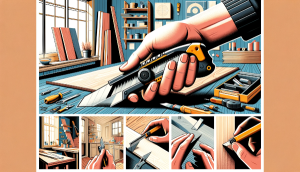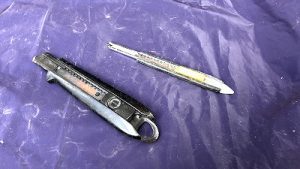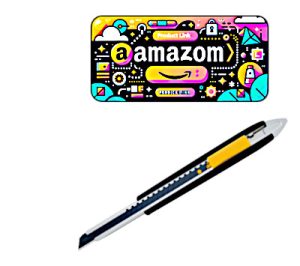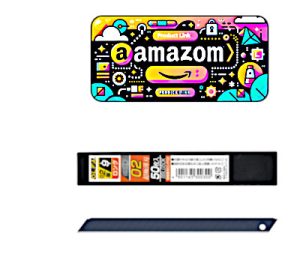In this installment, we’ll delve into the usage and selection of utility knives. A utility knife is a convenient and cost-effective tool, extensively employed in various crafting contexts. However, the utility knife’s versatility is profound, and maximizing its features while ensuring safe operation necessitates a certain level of knowledge. On this page, Japanese carpenters will offer detailed insights specifically for DIY enthusiasts on the nuances of using a utility knife in carpentry, including tips, safety precautions, and advice on selecting the right knife.
日本語版の記事(カッターナイフの使い方【プロの大工用】ボードカットなど)はコチラ
List of Contents
Article Author

Kentarou Fukata
A Kyoto, Japan native born in 1985, I am a seasoned carpenter boasting five national qualifications in housing-related disciplines in Japan. Committed to the dissemination of carpentry expertise, I actively contribute to professional development within the field through instructional content on YouTube.
Introduction Video
Complementing the guide is an informative video designed to augment comprehension.
If you wish to utilize features like subtitles, please reopen the video on YouTube. You can access the subtitles through the ‘CC’ button on the playback screen or in the settings.
Characteristics of a Utility Knife

While utility knives are undeniably convenient tools, they also possess the potential for accidents and injuries when used incorrectly. By thoroughly comprehending their unique features, one can harness their full performance potential while ensuring safety.
Feature1: Thin and Long Blade
One of the defining characteristics of a utility knife is its thin and long blade. The slimness of the blade allows for precise cutting, even in tight corners. Furthermore, by extending the blade, you can easily slice through thick materials such as insulation (foam, fiberglass, etc.).
Feature 2: No Need for Sharpening
Utility knives are advantageous because they don’t require sharpening due to the availability of affordable and sharp replacement blades. This makes them suitable for tasks where blade wear is a concern, such as cutting or shaving along concrete. Additionally, maintaining a sharp edge is effortless, as you can simply snap off the worn section to reveal a new, sharp edge. This contributes to precise and clean results.
Feature 3: Portability and Safety
Utility knives excel in portability due to their ability to safely retract the blade with ease. In construction projects, where various scenarios call for the use of sharp tools, this feature significantly increases the utility knife’s usage frequency, making it a go-to tool in diverse situations.
Key Points for Mastering Skills

We have compiled crucial points for mastering the technique of using a utility knife.
The Importance of Safety First
In carpentry, it’s common to use a utility knife without a cutting mat, but this practice carries the risk of damaging other items or causing personal injury. Such accidents can fundamentally undermine the essence of craftsmanship. When handling tools, always prioritize safety.
Pay Attention to the Importance of the Cutting Angle
When cutting through thick materials, it’s necessary to extend the blade and make precise incisions at the correct angle. This aspect is crucial across all carpentry skills, including the use of saws and nail guns. Mastery of this point is essential for quality craftsmanship in any task. Start honing this skill even with the simplest of tools, focusing on the cutting angle.
Focus on Mastering the Pressure Applied
When cutting the joint sections of wallpaper, Japanese wallpaper craftsmen are known for their skill in slicing through only the top two layers of wallpaper, without cutting the surface paper of the underlying plasterboard. This technique requires a delicate balance of pressure during cutting. To fully utilize the potential of a utility knife, focus on mastering this fine control of pressure.
Choosing the Right Utility Knife [Recommended Products]
Even within the realm of standard blade types, utility knives are equipped with various features such as retractable, screw-lock, and lock-back mechanisms. In this section, we’ll introduce recommended products that are actually used by professional carpenters in Japan, along with their features. (Includes promotional content)
This is a simple utility knife made by Tajima of Japan. When the blade is retracted, a convenient screwdriver is built into the front. The availability of different color options reduces the likelihood of mix-ups among carpenters. However, when cutting materials like fiberglass, the protrusion at the front of the handle may become an obstruction, so it is recommended to file it down.
This is the most commonly used (standard) size replacement blade for utility knives, manufactured by Kai Corporation. It comes highly recommended by a wallpaper craftsman acquaintance who frequently uses utility knives in his work.
t’s recommended to keep a small utility knife alongside the standard-sized ones. This type of knife excels in making cuts in directions that are challenging with a standard-sized knife. Although not suitable for heavy-duty cutting, it enhances your capacity for detailed work. This product, made by OLFA, can accommodate a longer blade than the usual small size and comes with a spatula attached to the rear of the handle, making it a multifunctional tool.
These are the extended-length replacement blades for the aforementioned small utility knife.
Safety Precautions for Using a Utility Knife

A utility knife is a sharp instrument and poses a risk of injury if not used correctly. Familiarity with its use can lead to complacency and increase the risk of accidents. Since injuries can have long-term consequences, it is crucial to exercise utmost caution while using it.
Be Aware of the Potential for Blade Breakage
Exerting excessive force on the tip of a utility knife can lead to the blade breaking during tasks. If the blade tip breaks, it can result in the blade being swung abruptly, potentially leading to serious accidents. Additionally, proper disposal of broken blade tips and used blades is essential. If they are disposed of with regular work waste, it can lead to unexpected injuries during transportation.
Hazard of the Blade Overriding the Cutting Ruler
When using a utility knife along a cutting ruler, there’s a chance that the blade may surpass the ruler’s edge. This type of accident tends to happen when you’re working forcefully and without due attention, and it can result in significant mishaps. Always be aware of this risk when employing a cutting ruler to ensure safety.
Specific Uses of a Utility Knife

Here we introduce specific examples of how Japanese craftsmen utilize utility knives in carpentry work.
General Usage
Even professional construction work often involves using a utility knife in the same general way as in household tasks. It’s commonly used for opening cardboard boxes, cutting insulation materials, installing protective covers, and slicing paper, sheets, or vinyl. The ability to quickly draw the knife from a tool belt, extend the blade, make the cut, retract the blade, and place it back in the tool belt is crucial for efficient work. The coordination of thought and action is key for swift operations.
Processing Building Materials
Wooden Plywood
Utility knives can be used for cutting hard wooden plywood. For example, it’s possible to cut 2.7mm plywood with just a utility knife. However, cutting wooden materials requires significant force. Depending on the situation, it’s advisable not to forcibly choose a utility knife but to consider using other tools as well.
Plasterboard
Various tools are utilized for processing plasterboard, but a utility knife and a hand saw can be sufficient. In new construction, power tools like circular saws are typically used for efficiency. However, in renovation projects where irregular shapes are needed, using only a utility knife can often result in cleaner and quicker work. Therefore, mastering the utility knife technique in renovation tasks holds value.
Handy Tricks

Scraping
A utility knife, with its replaceable blades, is ideal for scraping or stripping surfaces of materials like concrete that may cause blade wear. For such tasks, scrapers that can accommodate replacement blades are also handy. Moreover, the utility knife is well-suited for shaving tasks while the blade is in an upright position, making it useful for pre-sanding treatments or smoothing surfaces.
Scratch Marking
Many building materials that carpenters work with have glossy decorative surfaces and dark colors, making pencil marks hard to see and potentially leading to errors. In such cases, using the blade tip of a utility knife to create scratch marks enables precise and visible marking. This method involves using the back of the knife blade. By holding the blade upright and scraping with the back, you can prevent the blade from cutting too deeply and veering off in unintended directions.
Using the Attached Spatula
Finally, let’s introduce the method of using the spatula attached to the knife body. When cutting the corner parts of sheet-like building materials, merely pressing down can cause the material to curl up, making it hard to set the exact cutting position. Using the spatula to create an edge on the material allows for a clean cut along the corner angle. Having a spatula attached to the knife body streamlines this entire process.
Conclusion
Have you discovered any useful methods for the utility knife?
The utility knife is an extremely versatile tool, usable in a wide array of tasks. It’s often considered a tool for beginners, but its simplicity belies a depth in technique. I hope you will understand its characteristics, explore its potential, hone your skills, and enjoy the process of creation.




